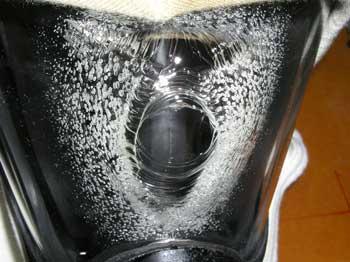
Typical fire-fighter breathing apparatus damaged in NIST tests shows facepiece warping under high heats.
As of Sept. 1, 2013, standard firefighter breathing equipment cannot be certified to National Fire Protection Association (NFPA) standards unless the facepiece lenses pass a new rigorous test developed by the National Institute of Standards and Technology (NIST).
The NIST-developed test is designed to reduce the degradation and possible failure of the facepiece lens in self-contained breathing apparatus (SCBA) under high-heat firefighting conditions. NFPA incorporated the NIST test into the 2013 update of its standard for SCBA units.
The 2013 version of NFPA's 1981 standard, published in January, 2013, contains a new "Elevated Temperature Heat and Flame Resistance Test" that exposes the SCBA to 500 °F (260 °C) for 5 minutes in an oven. This test is followed by 10 seconds of direct flame contact.
In addition, the new version contains a new "Lens Radiant Heat Test" that subjects the SCBA facepieces to a radiant heat flux of 15 kilowatts per square meter (kW/m2) for five minutes. As part of this test, the facepiece is required to maintain an air supply (positive pressure) inside the mask for a total of 24 minutes.
In controlled experiments, NIST researchers determined that an incident radiant heat flux of 15 kW/m2 would be a representative test criterion for determining the performance of SCBA facepiece lenses. It is representative of the flux experienced by firefighters approaching the onset of the deadly phenomenon known as flashover, a state of total surface involvement in a fire of combustible material within an enclosure. Also, the researchers found that measuring internal facepiece pressure was indicative of when holes formed and the effect of holes on firefighter air-supply duration and breathing protection.
The new test and test conditions are important advances in improving the performance of what has been, perhaps, the most vulnerable component of a firefighter's protective gear in high-heat conditions. Failure of a lens can expose a firefighter to toxic gases and can result in burns to the respiratory tract as well as asphyxiation. Documented problems include holes and extensive crazing as well as bubbling and deforming of lenses.
In several SCBA-related deaths, degraded masks were found affixed to the faces of victims who suffered thermal burns to their airways.
In the United States, SCBA makers submit their products for certification testing before they are sold. Until August 31, 2013, compliance to NFPA standards only requires passing a less severe "heat and flame test," specified in the 2007 version of NFPA 1981 and retained, with the new NIST test, in the recent update.
NIST experiments conducted during development of the new facepiece-lens test were supported, in part, by the Department of Homeland Security Science and Technology Directorate and the United States Fire Administration. The National Institute for Occupational Safety and Health (NIOSH) Fire Fighter Fatality and Injury Prevention Program played a critical role in identifying the lens degradation issue.

